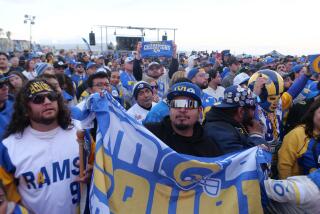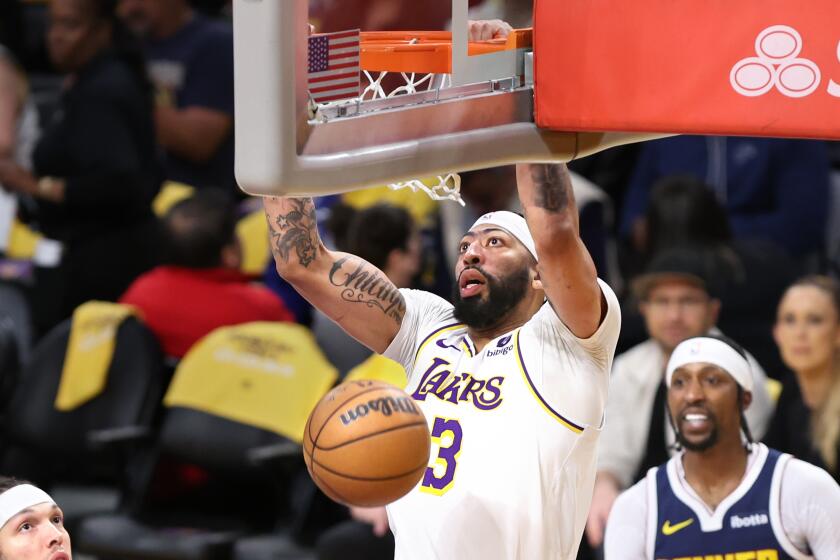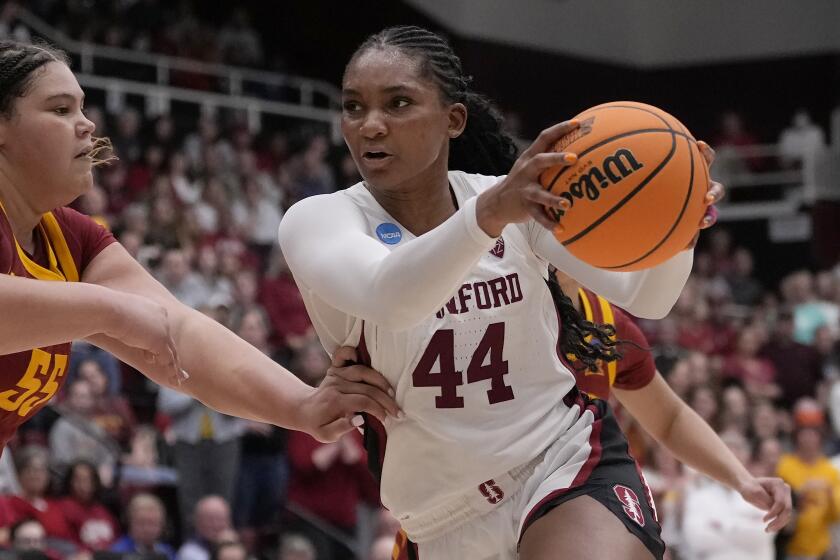This Problem Still Hasn’t Been Fixed
”. . . but when your luck runs dry, watch out. That’s when the nights grow long and the streets grow cold--and when that juice turns sour, baby, it’s more than your day that gets ruined. A New York minute--that’s all it takes to go from the top of the heap to the city dump.”
--The athletes’ lament,
from “City Dump”
*
It was and still is, 50 years later, the worst development in the history of college basketball.
The 1951 gambling scandal, first uncovered in New York City, wasn’t the first or last such scandal to hit college basketball--there had been others, dating to the ‘30s--but it was certainly the biggest to that time and it nearly flattened a young, growing game.
Other major scandals would hit college basketball, in 1961 and 1979, and the threat of another, NCAA administrators believe, still lurks, namely from the rise of student bookies and offshore gambling Web sites. But the ’51 scandal was the grabber.
On Feb. 18 of that year, New York District Attorney Frank Hogan announced the arrests of City College of New York stars Ed Warner, Ed Roman and Alvin Roth, after they’d confessed to deliberately losing three games during the 1950-51 season.
The story rocked the sport to its roots, because at the time, CCNY was the king of college basketball. In the previous season, it had won both the NCAA and NIT championships, the only time that happened.
In New York in 1951, the NBA was trying hard to catch on. The Knicks played their home games at the 69th Street Armory. Meanwhile, college basketball crowds of 18,000 were routine at Madison Square Garden, where Marty Glickman opened his broadcasts with, “Welcome to Madison Square Garden, the basketball capital of the world.”
The three CCNY players admitted receiving $1,500, $1,400 and $1,000 each for throwing games.
Two days later, Long Island University players Sherman White, Adolf Bigos and Leroy Smith admitted involvement in the scandal and were arrested.
They admitted to receiving $18,500 from gamblers for shaving points in seven games during the 1949-50 and 1950-51 seasons.
While college basketball lay prostrate in New York, the scandal moved westward. Players from Kentucky, Toledo and Bradley in Peoria, Ill., were swept up in the scandal.
In New York, there were more arrests.
Eventually, according to “The Journal of Sports History,” nationwide, the 1951 scandal involved 35 active and former college players accused of fixing 86 games between 1947 and 1951. Twenty of the players and 14 gamblers who’d bribed them were indicted and convicted.
Careers were ruined, the most prominent of which was Sherman White’s at LIU.
In the excellent HBO special on the scandals, “City Dump,” New York Times columnist Dave Anderson recalled the case of the 6-foot-8 White, who at the time was only 77 points away from the NCAA scoring record.
“If it weren’t for the scandals,” Anderson said, “the Knicks would have made White their territorial draft pick and the Knicks, not the Minneapolis Lakers, would have won all those NBA championships in the ‘50s. White might have become the NBA’s best player.”
A key figure in the 1951 scandal was a New York jeweler with a weakness for gambling, Salvatore Sollazzo. His point man was former Long Island player Eddie Gard, who was on a first-name basis with every prominent New York college player.
Gard wanted to organize a point-shaving scheme, but needed someone to bankroll it.
Enter Sollazzo.
Non-Nevada sports wagering then, as now, was illegal. But gamblers operated openly at Madison Square Garden. Sports columnist Jimmy Cannon, before the scandal broke, once called college basketball “the slot machine of college sports.”
Bookies could be found in any New York neighborhood and point spreads for basketball games were published in the newspapers.
In “City Dump,” two Madison Square Garden gamblers are actually caught on film, one handing over to another a handful of cash.
Gard befriended New York-area college stars at Catskills resorts, where they played in summer leagues.
One of his running mates was a former Manhattan College player, Hank Poppe. In January 1951, Poppe offered Manhattan center Junius Kellogg $1,000 to fix a game and Kellogg reported it. Poppe was arrested, along with three bookmaker associates.
The District Attorney’s office, prepared to crack down on illegal gambling, arrested CCNY’s Roman, Roth and Warner a month later.
CCNY had just beaten Temple at Philadelphia and boarded a New York-bound train. New York detectives got on at Camden, N.J., and sought out CCNY Coach Nat Holman, saying they wanted to speak to the three players.
The arrests were made as the train rolled into New York.
Gard was arrested the same day, White, Bigos and Leroy Smith of Long Island two days later.
The scandal went national in October ‘51, when Kentucky stars Ralph Beard, Alex Groza and Dale Barnstable were arrested, accused of throwing Kentucky’s first-round NIT game against Chicago Loyola in 1949.
The widening scandal had even brushed Los Angeles. On March 4, 1951, USC player Ken Flower reported to his coach, Forrest Twogood, that a gambler had offered him $1,500 to throw a game with UCLA.
Ultimately, Sollazzo, the key figure in New York, served 12 years in prison.
Basketball at CCNY was severely wounded and never did fully recover. The city colleges banned themselves from Madison Square Garden. Long Island dropped basketball completely for six years. Kentucky suspended basketball for a season.
*
As painful as the 1951 scandals were to the colleges, at least two--Bradley and New York University--apparently learned nothing from them. They were also implicated in the 1961 mess. This one, with arrests spanning two years, involved 50 players from 27 colleges. Between 1956 and ‘61, it was charged, 44 games had been rigged and 50 players had accepted close to $45,000 in bribe money.
The gamblers, of course, made millions.
North Carolina State was hit hard by the scandal. Three of the Wolfpack’s players were arrested, but because they cooperated with investigators and fingered the contact men, they were not indicted.
And just as the ’51 mess had cost Sherman White an NBA career, this one cost Connie Hawkins half of his.
The 6-8 Hawkins was already a New York playground legend when he enrolled at the University of Iowa in 1960. There, he met Jack Molinas, onetime Columbia star who’d been thrown out of the NBA in 1954 for shaving points while playing for the Fort Wayne Pistons.
Hawkins was never charged with a crime. But he was guilty of not being careful with whom he associated. Molinas, Hawkins later admitted, once lent him $200.
When Molinas and his associate, Joe Hacken, were accused of masterminding a widespread gambling ring, Hawkins, a freshman not even eligible to play varsity basketball, was swept up.
Because he had associated with Molinas, he was taken back to New York by investigators from a multi-agency task force. When he admitted to the loan, he was freed. Iowa kicked him out of school--and the NBA blackballed him.
Hawkins filed suit against the NBA in 1966 and his case was settled in 1969, when he was 27. This, after years of playing with the Harlem Globetrotters and the ABA. He signed a five-year deal with the Phoenix Suns that included $410,000 in salary, a $600,000 annuity, a $250,000 cash bonus and $35,000 for legal bills.
He was an instant NBA all-star, played nine seasons and in 1992 was named to the basketball Hall of Fame.
Molinas and Hacken both served prison terms, Molinas for five years. He moved to Hollywood, where he became a furrier and pornography trafficker. On Aug. 3, 1975, in a case that was never solved, he was shot and killed in the backyard of his Hollywood Hills home.
*
In 1981, gambler Henry Hill told federal agents that during the 1978-79 season, he had paid Boston College players Rick Kuhn, Jim Sweeney and Ernie Cobb $2,500 a game to fix nine games.
Hill said he’d netted $75,000-$100,000.
“Not bad for 11 weeks’ work,” he wrote in a first-person piece for Sports Illustrated in 1981.
Kuhn wound up serving 28 months in prison. His teammates were not charged.
Hill, who was already in the Justice Department’s witness protection program after a 1980 arrest for his role in a cocaine-smuggling ring, cooperated in the prosecution’s gambling case and was not prosecuted.
*
The beat goes on:
* For his point shaving in Arizona State games during the 1993-94 season, player Stevin Smith was sentenced to a year in prison and fined $8,000.
A teammate, Isaac Burton Jr., spent two months in jail, six months in home detention and was fined $8,000.
Benny Silman, the Arizona State student who masterminded the point shaving, was sentenced to 46 months and is serving his term at a federal prison camp in Yankton, S.D.
* In 1998, Northwestern teammates Kenneth Dion Lee and Dewey Williams were sentenced to a month in jail by a federal judge. Their bookie, former Notre Dame football kicker Kevin Pendergast, who paid bribes to the players, spent two months in prison.
*
How long before the next scandal?
Bill Saum, the NCAA’s point man in its gambling-awareness program for students, athletes and coaches, says more elements are in place now for another such scandal than ever before.
The current fear: student bookies.
“We have reason to believe there are bookies on every campus in America,” he said.
“That, combined with Caribbean-based gambling Web sites, is a real concern. Using U.S. phone lines to place wagers with those sites is illegal. But with every student having a credit card and access to a computer--it scares us to death.”
*
One of the members of the 1951 CCNY team, Floyd Layne, now a Brooklyn high school coach, at first agreed to be interviewed for this story.
But when called for the interview, he deferred questions to his lawyer, who explained that none of the surviving players are talking.
Turns out, exclusive rights to their stories have been acquired by a film production company.
More to Read
Get our high school sports newsletter
Prep Rally is devoted to the SoCal high school sports experience, bringing you scores, stories and a behind-the-scenes look at what makes prep sports so popular.
You may occasionally receive promotional content from the Los Angeles Times.






